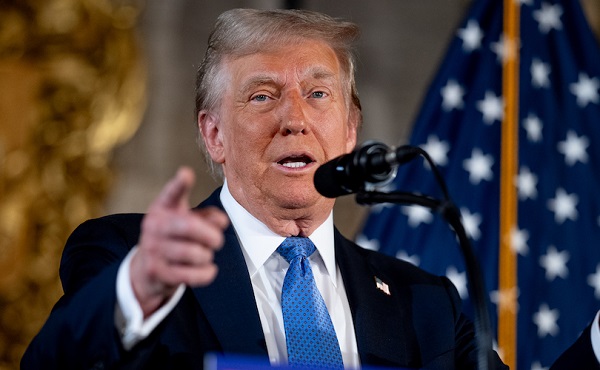Business
Declining Canadian dollar could stifle productivity growth in Canada

From the Fraser Institute
By Steven Globerman and Lawrence Schembri
The Bank of Canada’s decision last week to lower its policy rate by 50 basis points increases the gap between the U.S. Federal Reserve’s policy rate and the Bank of Canada’s rate to approximately 130 basis points. While this gap might close somewhat if the Federal Reserve lowers its rate at its meeting this week, a substantial U.S. premium will still exist.
Since borrowing rates are tied to policy rates, interest rates in Canada will remain well below those in the U.S. for the foreseeable future. This gap will continue to put downward pressure on the value of the Canadian dollar against the U.S. greenback, as investors favour higher-earning U.S. dollar-denominated assets over Canadian dollar assets. President-elect Trump’s threatened trade actions against Canada could also exert further downward pressure on the loonie, especially if the Bank of Canada responds to Trump’s actions by making additional rate cuts. For context, it took $1.33 Canadian dollars to purchase one U.S. dollar on January 1, 2024, compared to $1.43 Canadian dollars on December 13, 2024. This represents a substantial depreciation in the Canadian dollar’s value of approximately 7.6 per cent over the period.
What effects will a declining Canadian dollar have on the Canadian economy?
In short, it will increase demand for domestic output and labour and put upward pressure on inflation via higher import prices, and it could also lower productivity growth and further hurt living standards.
Why the impact on productivity?
Because Canada imports most of its machinery and equipment (including information and communications technology) from the U.S. and other countries, and investment in this type of physical capital helps drive productivity growth. A declining Canadian dollar makes capital equipment imports more expensive, thereby discouraging investment and slowing productivity growth. A declining Canadian dollar may also shelter domestic firms from foreign competition, which could dampen their incentive to invest in productivity-enhancing assets, even if they price their output in U.S. dollars.
Hence, if the Canadian dollar remains weak against the U.S. dollar and other currencies, it may be more difficult to reverse Canada’s productivity woes. Again, productivity—the amount of GDP per hour of labour the economy produces—is key to improving living standards, which have been on the decline in Canada. From July to September of 2024, the economy grew by 0.3 per cent yet per-person GDP (an indicator of living standards) fell by 0.4 per cent (after adjusting for inflation).
Canada also indirectly imports technology via direct investments made by U.S.-based companies in their Canadian subsidiaries. While a declining Canadian dollar makes it cheaper for U.S. companies to buy assets in Canada, it also reduces the U.S. dollar value of profits earned over time in Canada by American-owned companies. This phenomenon, combined with an unstable Canadian dollar, might discourage inward foreign direct investment and associated technology transfers by increasing the financial uncertainty of such investment.
To be clear, this is not a criticism of the Bank of Canada’s move last week to help lower domestic interest rates given the Bank’s primary mandate to meet its inflation rate target of 2 per cent. Rather, governments—including the Trudeau government—must enact policies to encourage business investment in productivity-enhancing assets.
For starters, policymakers should reduce business tax rates and the tax rate on capital gains, to encourage innovation and entrepreneurship. They should also dramatically reduce the regulatory burden and other barriers to entry and growth, especially those faced by small and medium-sized businesses. And the federal and provincial governments should increase competition in the domestic economy by reducing interprovincial trade barriers.
For example, the provinces could adopt a policy of “mutual recognition” so the standards and licencing requirements in one province would be accepted by all provinces. Provinces can also unilaterally eliminate self-imposed trade barriers (as Alberta did in 2019 with grazing permits for livestock). Of course, due to resistance from special interest groups that benefit from internal barriers, such reforms will not be easy. But the economic risks to the Canadian economy—from even the threat of a trade war with the U.S.—could generate support among Canadians for these reforms. Indeed, reducing interprovincial barriers to trade and labour mobility might be the single most important thing that governments in Canada could do to improve productivity.
With Canada’s lower inflation rate, weaker labour market and weaker economic growth outlook compared to the U.S., lower interest rates in Canada seem appropriate. Bank of Canada Governor Tiff Macklem wants to see economic activity pick up to absorb slack in the economy and prevent inflation settling below the bank’s 2 per cent target. Clearly, the Bank should focus on inflation and domestic economic conditions. But policymakers must do their part to create a better environment for investment and innovation, the keys to productivity and increased living standards for Canadians.
Business
Trump confirms 35% tariff on Canada, warns more could come

Quick Hit:
President Trump on Thursday confirmed a sweeping new 35% tariff on Canadian imports starting August 1, citing Canada’s failure to curb fentanyl trafficking and retaliatory trade actions.
Key Details:
- In a letter to Canadian Prime Minister Mark Carney, Trump said the new 35% levy is in response to Canada’s “financial retaliation” and its inability to stop fentanyl from reaching the U.S.
- Trump emphasized that Canadian businesses that relocate manufacturing to the U.S. will be exempt and promised expedited approvals for such moves.
- The administration has already notified 23 countries of impending tariffs following the expiration of a 90-day negotiation window under Trump’s “Liberation Day” trade policy.
Diving Deeper:
President Trump escalated his tariff strategy on Thursday, formally announcing a 35% duty on all Canadian imports effective August 1. The move follows what Trump described as a breakdown in trade cooperation and a failure by Canada to address its role in the U.S. fentanyl crisis.
“It is a Great Honor for me to send you this letter in that it demonstrates the strength and commitment of our Trading Relationship,” Trump wrote to Prime Minister Mark Carney. He added that the tariff response comes after Canada “financially retaliated” against the U.S. rather than working to resolve the flow of fentanyl across the northern border.
Trump’s letter made clear the tariff will apply broadly, separate from any existing sector-specific levies, and included a warning that “goods transshipped to evade this higher Tariff will be subject to that higher Tariff.” The president also hinted that further retaliation from Canada could push rates even higher.
However, Trump left the door open for possible revisions. “If Canada works with me to stop the flow of Fentanyl, we will, perhaps, consider an adjustment to this letter,” he said, adding that tariffs “may be modified, upward or downward, depending on our relationship.”
Canadian companies that move operations to the U.S. would be exempt, Trump said, noting his administration “will do everything possible to get approvals quickly, professionally, and routinely — In other words, in a matter of weeks.”
The U.S. traded over $762 billion in goods with Canada in 2024, with a trade deficit of $63.3 billion, a figure Trump called a “major threat” to both the economy and national security.
Speaking with NBC News on Thursday, Trump suggested even broader tariff hikes are coming, floating the idea of a 15% or 20% blanket rate on all imports. “We’re just going to say all of the remaining countries are going to pay,” he told Meet the Press moderator Kristen Welker, adding that “the tariffs have been very well-received” and noting that the stock market had hit new highs that day.
The Canadian announcement is part of a broader global tariff rollout. In recent days, Trump has notified at least 23 countries of new levies and revealed a separate 50% tariff on copper imports.
“Not everybody has to get a letter,” Trump said when asked if other leaders would be formally notified. “You know that. We’re just setting our tariffs.”
Business
Trump slaps Brazil with tariffs over social media censorship

From LifeSiteNews
By Dan Frieth
In his letter dated July 9, 2025, addressed to President Luiz Inácio Lula da Silva, Trump ties new U.S. trade measures directly to Brazilian censorship.
U.S. President Donald Trump has launched a fierce rebuke of Brazil’s moves to silence American-run social media platforms, particularly Rumble and X.
In his letter dated July 9, 2025, addressed to President Luiz Inácio Lula da Silva, Trump ties new U.S. trade measures directly to Brazilian censorship.
He calls attention to “SECRET and UNLAWFUL Censorship Orders to U.S. Social Media platforms,” pointing out that Brazil’s Supreme Court has been “threatening them with Millions of Dollars in Fines and Eviction from the Brazilian Social Media market.”


Trump warns that these actions are “due in part to Brazil’s insidious attacks on Free Elections, and the fundamental Free Speech Rights of Americans,” and states: “starting on August 1, 2025, we will charge Brazil a Tariff of 50% on any and all Brazilian products sent into the United States, separate from all Sectoral Tariffs.” He also adds that “Goods transshipped to evade this 50% Tariff will be subject to that higher Tariff.”
Brazil’s crackdown has targeted Rumble after it refused to comply with orders to block the account of Allan dos Santos, a Brazilian streamer living in the United States.
On February 21, 2025, Justice Alexandre de Moraes ordered Rumble’s suspension for non‑compliance, saying it failed “to comply with court orders.”
Earlier, from August to October 2024, Moraes had similarly ordered a nationwide block on X.
The court directed ISPs to suspend access and imposed fines after the platform refused to designate a legal representative and remove certain accounts.
Elon Musk responded: “Free speech is the bedrock of democracy and an unelected pseudo‑judge in Brazil is destroying it for political purposes.”
By linking censorship actions, particularly those targeting Rumble and X, to U.S. trade policy, Trump’s letter asserts that Brazil’s judiciary has moved into the arena of foreign policy and economic consequences.
The tariffs, he makes clear, are meant, at least in part, as a response to Brazil’s suppression of American free speech.
Trump’s decision to impose tariffs on Brazil for censoring American platforms may also serve as a clear signal to the European Union, which is advancing similar regulatory efforts under the guise of “disinformation” and “online safety.”
With the EU’s Digital Services Act and proposed “hate speech” legislation expanding government authority over content moderation, American companies face mounting pressure to comply with vague and sweeping takedown demands.
By framing censorship as a violation of U.S. free speech rights and linking it to trade consequences, Trump is effectively warning that any foreign attempt to suppress American voices or platforms could trigger similar economic retaliation.
Reprinted with permission from Reclaim The Net.
-

 International2 days ago
International2 days agoSecret Service suspends six agents nearly a year after Trump assassination attempt
-

 Bruce Dowbiggin2 days ago
Bruce Dowbiggin2 days agoThe Covid 19 Disaster: When Do We Get The Apologies?
-

 Crime24 hours ago
Crime24 hours agoSweeping Boston Indictment Points to Vast Chinese Narco-Smuggling and Illegal Alien Labor Plot via Mexican Border
-

 Alberta1 day ago
Alberta1 day agoAlberta school boards required to meet new standards for school library materials with regard to sexual content
-

 Automotive2 days ago
Automotive2 days agoAmerica’s EV Industry Must Now Compete On A Level Playing Field
-

 Environment1 day ago
Environment1 day agoEPA releases report on chemtrails, climate manipulation
-

 Business13 hours ago
Business13 hours agoTrump slaps Brazil with tariffs over social media censorship
-

 Business2 days ago
Business2 days ago‘Experts’ Warned Free Markets Would Ruin Argentina — Looks Like They Were Dead Wrong





